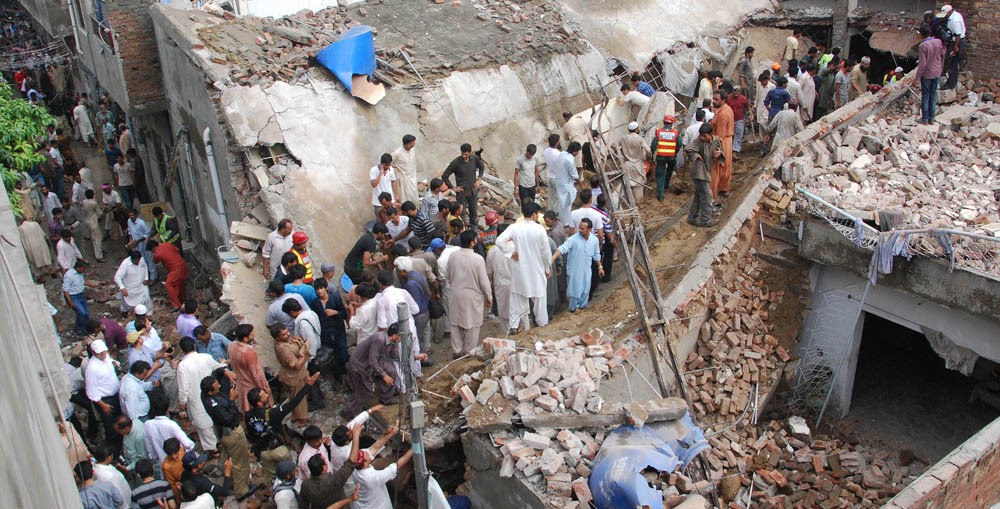
Substandard construction material and official negligence led to the collapse of Jamia Hanfia’s roof

As rain wreaked havoc in Lahore on September 9, 2014, the roof of Jamia Hanfia in Daroghawala area collapsed, killing at least 24 people and injuring around a dozen.
Up to 40 namazis that had assembled to offer zuhr prayers were trapped in the mosque. Rescue operation started with local help who were joined in by Rescue 1122. It took two days to clear the accident site.
Zahid Bahsir, 35, was hit on his head and shoulders by the falling roof. "Everything around me turned dark," he recalls.
In hindsight, he says, the structure of the mosque "did not look okay. But, we have learnt a lesson - that things can be different from the way they appear".
Investigations have revealed that the tragedy happened due to negligence of the mosque committee, comprising local influential; faulty structure; lack of oversight by government authorities and; to an extent, the inclement weather.
The tragedy was followed by customary visits of political elite and the announcement of compensations to the families of the deceased. The amount offered was Rs1,600,000 per casualty, which is much higher than what is usually given to victims of similar tragedies.
Haji Muhammad Javed, President, Gujjarpura Scheme Welfare Society, says he has learnt from sources that the mosque committee was experimenting with construction techniques and did not seek advice from anyone. "The ground floor, pillars and foundations were not strong enough to bear the extra weight of the upper storey constructed five years ago. The rainwater accumulated on the rooftop further weakened the structure," he adds.
He thinks it is a pity that mosques are mostly built with charity money and quite often there is no single financer who can ensure the judicious use of these funds. "The incidents of misuse are common. Often substandard construction material is used. Sometimes people donate substandard construction material such as cement, steel, iron bars etc. without realising the dangers involved," Javed says.
According to him, people who come here to pray regularly do not have a sense of ownership, and they are not allowed question the mosque committee.
Javed, who is a member of the Tableeghi Jamaat, says the district government issues NOCs for construction of new mosques but it does not bother to inspect the under-construction sites and the quality of material used.
Javed’s Tableegi Jamaat had applied for construction of mosque in his locality but it was denied permission on grounds that the number of the Tableegi Jamaat members in the area was not enough and that they should offer prayers in mosques belonging to other sects.
"Is the DCO only concerned about maintaining sect-wise records of followers? Why doesn’t he perform the task of assuring quality and risk-free construction and expansion of mosques?"
He adds the DCO seeks opinion of police, town administration, district khateeb, works and services department before issuing NOC -- "But all these departments disappear afterwards. Why can’t the engineering department inspect mosques which are public buildings? They simply issue warnings about dangerous buildings as an annual customary obligation".
Tariq Zaman, Personal Staff Officer to DCO Lahore, says "True, the mosque was not issued an NOC but this mosque was constructed 40 years ago. The second storey was added without realising that the mud foundations laid 40 years ago were not strong enough to bear this additional weight."
He says the main reason behind this tragedy was that the roof was made of single layer of bricks covered by one-foot thick layer of mud. The rainwater kept seeping into this layer of mud, making it too heavy for the weak structure to bear. The base of the mosque, which was all mud, was swept away by the rainwater accumulated in the locality.
"It is an accident," Zaman says, adding the district government is working on a plan on how to avoid such catastrophes in future.
Zaman says this year they have issued notices to around 3,500 buildings that are dangerous and may get further damaged with time. But, he says, "people are reluctant to vacate them as there is no clear-cut plan to relocate them. Many of these buildings are on rent. The tenants are not concerned about the risks to buildings and the landlords are not worried about potential risks to lives of the inhabitants."
Mufti Intekhab, Punjab Coordinator of the Committee on Ittehad Bain-ul-Muslimeen, formed by Punjab Chief Minister, says they have taken up the matter and will soon be forwarding suggestions for revision in NOC issuance mechanism. "Just as it is compulsory for the applicants to provide land ownership details of mosque sites, they shall also be asked to provide construction plans approved by qualified architects and civil engineers. It is also suggested that the expansion plans of mosques and construction material should also be subjected to inspections," he says.